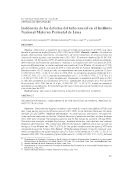Resultados: visualización detallada
Registro 1 de 1 para la búsqueda Autor SA Y Institución Biblioteca Universitaria de Chile
Incidencia de los defectos del tubo neural en el Instituto Nacional Materno Perinatal de Lima
Carolina Tarqui-Mamani; Instituto Nacional de Salud. Ministerio de Sa
Hernán Sanabria; Instituto Nacional de Salud. Ministerio de Sa
Nelly Lam; Instituto Nacional Materno Perinatal. Ministe
Juan Arias
2009
-
Datos de edición
Revista Chilena de Salud Pública; Vol. 13, No. 2 (2009)
Universidad de Chile - Tipo de Documento Prensa y Revistas
-
Materia
Tubo neural, malformación, ácido fólico, fortificación, incidencia.
Neural tube, malformation, folic acid, fortification, incidence. -
Descripción
Objetivo: Determinar la tendencia de la tasa de incidencia hospitalaria de DTN y sus tipos durante el periodo de prefortificación (2001 - 2005) en el INMP. Material y método: Se realizó un estudio observacional, descriptivo, retrospectivo y de corte transversal. Se revisaron historias clínicas de recién nacidos y sus madres entre 2001 ...Objetivo: Determinar la tendencia de la tasa de incidencia hospitalaria de DTN y sus tipos durante el periodo de prefortificación (2001 - 2005) en el INMP. Material y método: Se realizó un estudio observacional, descriptivo, retrospectivo y de corte transversal. Se revisaron historias clínicas de recién nacidos y sus madres entre 2001 - 2005. El universo muestral fue 93.863 RN, de los cuales 128 RN tuvieron DTN. El análisis univariado incluyó promedio, desviación estándar, determinación de frecuencias absolutas y relativas y la comparación entre los datos de DTN, según los diferentes años, se realizó mediante una prueba de Prais Winsten. Se calculó el IC 95% para la incidencia global y los tipos de DTN a través del Test de Poisson. Resultados: Los DTN fluctuaron entre 18 y 32 casos por año, correspondiendo una tasa hospitalaria global de 13,6 por 10 000 RN (IC 95%: 11,38;16,21) entre el 2000 - 2005. La incidencia de espina bífida fue 8,3 x 10 000 (IC 95%: 6,57;10,37), seguida de anencefalia con 5,1 x 10 000 (IC 95%: 3,77;6,78) y 0,2 x 10 000 (IC 95%: 0,03; 0,77) para encefalocele. Finalmente, la tendencia de DTN entre el 2001 al 2005 fue ascendente no significativa (p=0,951). Conclusión: El promedio de la TGI de DTN en el período 2001 - 2005 fue de 13,6 por 10,000 RN (IC: 11,38;16,21), siendo su tendencia ascendente no significativa. El mielomeningocele tuvo la más alta tasa de incidencia en relación a los otros tipos de DTN.Objective: Determine the hospital incidence rate trends for neural tube defects (NTDs) and their types during the pre - fortification period (2001 - 2005) at the National Maternal - ...Objective: Determine the hospital incidence rate trends for neural tube defects (NTDs) and their types during the pre - fortification period (2001 - 2005) at the National Maternal - Perinatal Institute of Lima (INMP). Material and method: An observational, descriptive, retrospective, cross sectional study was carried out. Medical histories of newborns and their mothers between 2001 - 2005 were reviewed. The sampling universe was 93.863 newborns, of which 128 had NTDs. The univariate analysis included the average, standard deviation, and absolute and relevant frequency determination. The comparison between the data for different years was carried out through a Prais Winsten test. The CI of 95% for the global incidence and the types of NTD was calculated through the Poisson Test. Results: NTDs fluctuated between 18 and 32 cases per year, which corresponds to the global hospital rate of 13.6 per 10,000 newborns (CI 95%: 11.38;16.21) between 2000 - 2005. The incidence of spina bifida was 8.3 x 10,000 (CI 95%: 6.57;10.37), followed by anencephaly with 5.1 x 10,000 (CI 95%: 3.77;6.78) and 0.2 x 10,000 (CI 95%: 0.03; 0.77) for encephalocele. Finally, the tendency of NTDs between 2001 to 2005 showed a not significant increase (p=0.951). Conclusion: The average NTD global incidence rate in the period of 2001 - 2005 was 13.6 per 10,000 newborns (CI: 11.38;16.21), showing a not significant rising trend. Myelomeningocele had the highest incidence rate in relation to the other types of NTD.Escuela de Salud Pública - Facultad de Medicina
- Identificador 46302
- Enlace a todos los ejemplares de la revista






